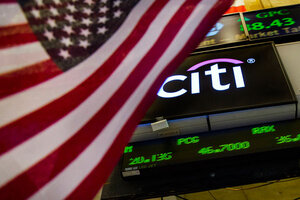Citigroup nears $7 billion settlement: Are banks chastened, post-crisis?
Many big banks have had to pay billion-dollar fines since 2008 for wrongdoing. The money may have caught banks' attention, but they are still big, powerful, and capable of risky behavior.

Citigroup, its logo pictured from the floor of the New York Stock Exchange, is reported to be considering a $7 billion settlement with the Justice Department.
Brendan McDermid/Reuters
Washington
If the giant bank Citigroup agrees to a $7 billion mortgage-fraud settlement, it would be among the largest in a string of large payments by banking behemoths in response to allegations of wrongdoing.
But the rumored dollar value of the settlement, which emerged in news reports Wednesday, has to be measured against the gargantuan size of firms like Citigroup.
Have big banks gotten a slap on the wrist since 2008 or meaningful punishment for bad behavior – including shoddy mortgage practices that helped to lay the groundwork for the crisis?
The answer is somewhat in the eye of the beholder: America’s titans of finance remain very large, powerful, and capable of risky behavior, but they are also at least somewhat chastened by tougher regulatory treatment and legal scrutiny.
For example, the $7 billion figure would equal about half of one year’s profits at Citigroup. That’s not an existential threat to the bank, but it’s more than chump change. The settlement stems from a Justice Department investigation into whether the bank defrauded customers who bought mortgage-related securities in the runup to the housing bust. An official announcement of the settlement could come next week, Reuters reported, citing a source with knowledge of the issue.
This would follow a string of billion-dollar settlements by banks regarding alleged wrongdoing in recent years. Some key examples:
$25 billion. This amount was agreed in 2012 by Wells Fargo, JPMorgan Chase, Bank of America, and Ally Financial for alleged foreclosure abuses.
$13 billion. JPMorgan Chase & Co agreed in 2013 to pay $13 billion to resolve Justice Department probes similar to what Citigroup is facing.
$9.3 billion. Numerous banks including Bank of America, Wells Fargo, and JPMorgan agreed to this amount of relief to homeowners in 2013 over alleged foreclosure abuses.
Beyond those examples, European banks have taken hits, too, paying US penalties related to alleged ties to tax evasion, money laundering, and evasion of economic sanctions against nations like Iran.
What does all this mean for the big banks?
Their stock prices aren’t roaring ahead. Only one of America’s big four commercial banking firms (Wells Fargo) has a stock price that has matched the Standard & Poor’s 500 stock index – whether you measure over one, five, or 10 years. The financial crisis took a severe toll on shareholders in Citigroup and Bank of America – imposing a smaller hit on JPMorgan. The stocks of those three are down for 2014 so far, even as the S&P index has risen more than 7 percent.
They’ve retained huge market clout. At the end of 2013, the five largest firms held 44 percent of total bank assets, up from about 38 percent in 2007, according to government figures analyzed by economist Gary Shilling, whose research firm is based in Springfield, N.J. This happened partly because of mergers that occurred during the crisis, as healthier banks gobbled up troubled rivals.
They’ve remained quite profitable. Last year, large US banks (those with assets above $10 billion) posted net operating income of nearly $152 billion – besting the prior record set in 2006, according to data tracked by the Federal Deposit Insurance Corp. That said, analysts say that banks face challenges on the earnings front as post-crisis regulations steer them out of risky trades and traditional lending.
Executive heads haven’t rolled. “Regulators are responding to pressure from Congress and the public to get tough on wayward large financial institutions,” Mr. Shilling writes in a recent report on the industry. He says regulators are demanding more than token fines and that some employees lose their jobs, but that “they have not been able to send any big fish to jail.”
They continue to lobby politicians. Even as their fortunes began sagging in 2007, banks stepped up their spending to lobby Congress year by year, with the amount holding roughly steady since 2011 at more than $60 million per year. Partly, that’s par for the course. But it can also be viewed as a recognition by the industry that its fate is tied inextricably to a shifting regulatory climate. When investment companies and insurance firms are added in alongside commercial banks, the financial sector tops other industries except for health care in total lobbying.

